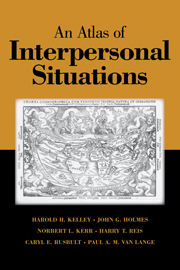Book contents
- Frontmatter
- Contents
- Preface
- PART ONE INTRODUCTION AND THEORY
- 1 Interpersonal Situations: The Context of Social Behavior
- 2 Outcome Interdependence
- 3 Interaction Conditions and Person Factors
- 4 Exploring the Geography of the Outcome Patterns
- PART TWO THE SITUATIONS
- Single-Component Patterns
- Two- and Three-Component Patterns
- Time-Extended Patterns
- Incomplete Information Situations
- N-Person Situations
- Movement from One Situation to Another
- PART THREE EPILOGUE
- References
- Author Index
- Subject Index
3 - Interaction Conditions and Person Factors
Published online by Cambridge University Press: 21 October 2009
- Frontmatter
- Contents
- Preface
- PART ONE INTRODUCTION AND THEORY
- 1 Interpersonal Situations: The Context of Social Behavior
- 2 Outcome Interdependence
- 3 Interaction Conditions and Person Factors
- 4 Exploring the Geography of the Outcome Patterns
- PART TWO THE SITUATIONS
- Single-Component Patterns
- Two- and Three-Component Patterns
- Time-Extended Patterns
- Incomplete Information Situations
- N-Person Situations
- Movement from One Situation to Another
- PART THREE EPILOGUE
- References
- Author Index
- Subject Index
Summary
This chapter continues our discussion of the properties of interdependence situations. It first considers the two conditions that affect how people can go about using their outcome controls to select among the various pairs of outcomes made possible in a situation. These are the response conditions – the sequential-temporal structure that governs when and in what order the behavioral responses possible in a situation can be exercised, and information conditions, which affect what the persons know and can communicate to each other. This chapter describes how we distinguish and represent those conditions.
Then we briefly consider the determinants of a situation and the question of its “reality.” Finally, we turn our attention to the “person factors” that enter into the interaction in particular situations. These are the interpersonal attitudes and values that people bring to and express through their interdependence. It will be recalled that our overarching model is that interaction is jointly determined by the situation and by the “person factors” of the two persons. In the Atlas's entries describing various important kinds of situation, we consider both the “person factors” relevant to each one and some of the patterns of interaction generated by partners for whom those particular factors are operative.
Some Examples of Response Conditions and Information Conditions
Recalling Eamon and Kyoko, we know that to accomplish their coordination task of removing the log that blocked their way, it was necessary for them to lift their respective ends at the same time.
- Type
- Chapter
- Information
- An Atlas of Interpersonal Situations , pp. 51 - 81Publisher: Cambridge University PressPrint publication year: 2003



